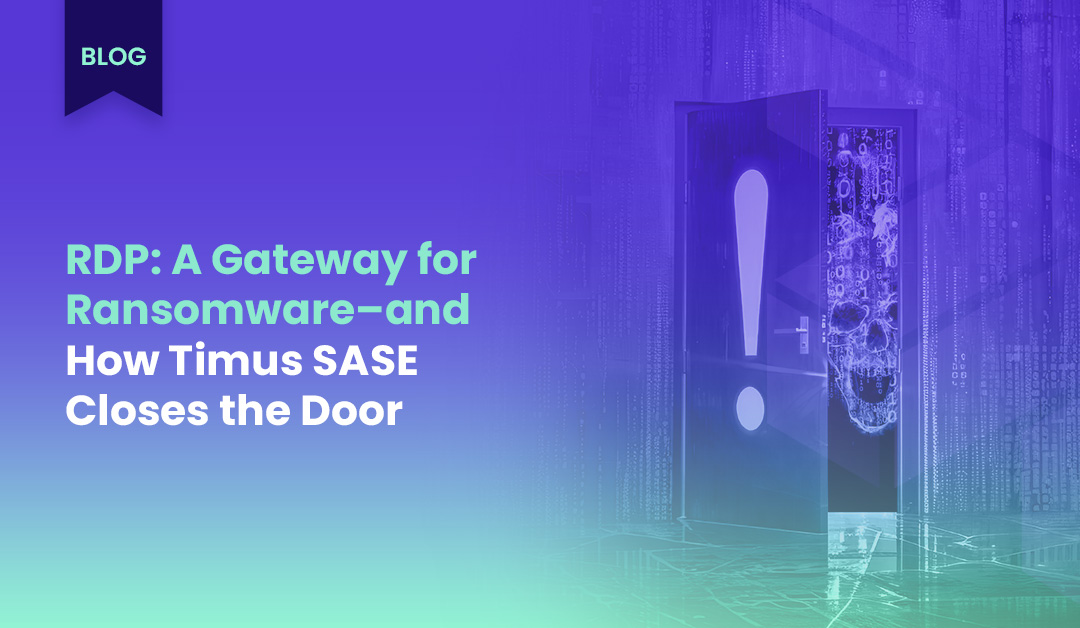RDP: A Gateway for Ransomeware – and How Timus SASE Closes the Door
Learn how RDP opens the door to ransomware attacks and how Timus SASE secures your network by closing this critical vulnerability. Remote Desktop Protocol (RDP) has long been a staple for IT teams, enabling remote access to systems and facilitating remote work. However, its widespread use has also made it a prime target for cybercriminals. Recent statistics underscore the critical vulnerabilities associated with RDP and highlight the urgent need for robust security measures.
Author
Date
Category
All Categories
- AI-powered security
- Attacks & Threats
- Cybersecurity
- Hybrid Cloud
- Network
- Network Firewall
- Network Protection
- News
- Remote Workforce
- Security
- Zero Trust
Contents
Popular Posts
Product
Join the Newsletter

Remote Desktop Protocol (RDP) has long been a staple for IT teams, enabling remote access to systems and facilitating remote work. However, its widespread use has also made it a prime target for cybercriminals. Recent statistics underscore the critical vulnerabilities associated with RDP and highlight the urgent need for robust security measures.
The Alarming Rise of RDP Exploits
In 2023, Sophos reported that RDP compromise was present in 90% of ransomware incidents they investigated, marking an unprecedented level of abuse. Attackers often exploit exposed RDP ports, weak credentials, and unpatched vulnerabilities to gain unauthorized access to systems. Once inside, they can deploy ransomware, exfiltrate data, and cause significant operational disruptions.
The situation has only worsened. In 2024, ransomware attacks surged globally, with over 5,400 published attacks—an 11% increase from the previous year. Notably, the United States remained the most targeted country, accounting for more than 50% of global ransomware incidents. The average ransom demand also escalated, reaching $2.73 million, nearly $1 million more than in 2023.
The Cost of Inadequate RDP Security
The consequences of RDP-based attacks are severe. Organizations face not only financial losses but also reputational damage and operational downtime. The average downtime following a ransomware attack is 24 days, during which businesses may be unable to operate effectively. Furthermore, 60% of organizations that paid a ransom experienced revenue loss, and 53% reported brand damage.
A notable example is the 2024 ransomware attack on Change Healthcare, where attackers exploited remote access vulnerabilities to infiltrate systems. The breach disrupted healthcare services nationwide and exposed sensitive patient data, affecting millions.
Timus SASE: Fortifying RDP with Zero Trust Architecture
At Timus Networks, we recognize the critical need to secure RDP access without hindering operational efficiency. Our Secure Access Service Edge (SASE) solution integrates Zero Trust principles to provide comprehensive protection against RDP-based threats.
Key Features:
- Zero Trust Network Access (ZTNA): Ensures that only authenticated and authorized users can access specific applications, eliminating implicit trust.
- Micro-Segmentation: Divides the network into isolated segments, preventing lateral movement by attackers within the network.
- Continuous Monitoring: Implements real-time monitoring and analytics to detect and respond to suspicious activities promptly.
- Multi-Factor Authentication (MFA): Adds an extra layer of security, making it significantly harder for attackers to gain unauthorized access.
- Encrypted Tunnels: Secures data in transit, protecting against eavesdropping and man-in-the-middle attacks.
- Dedicated Static IP-based Access: Even if a hacker steals employee credentials via phishing or social engineering, they will not be able to access the network without the Timus Connect agent installed on their devices.
By adopting Timus SASE, organizations can effectively isolate RDP services, enforce strict access controls, and monitor user activities, thereby significantly reducing the risks associated with RDP vulnerabilities.
Conclusion
The exploitation of RDP remains a significant vector for ransomware attacks, posing substantial risks to organizations worldwide. Implementing a robust, Zero Trust-based security framework is essential to safeguard against these threats. Timus SASE offers a comprehensive solution to secure RDP access, protect sensitive data, and ensure business continuity.
Protect your organization from RDP-based threats with Timus SASE. Learn more at Timus Networks.
References
Infosecurity Magazine. (2023, October 9). RDP Abuse Responsible for 90% of Ransomware Breaches. Retrieved from https://www.infosecurity-magazine.com/news/rdp-abuse-90-ransomware-breaches/
Varonis. (2023, October 5). Ransomware Statistics: Trends, Attacks, and Facts for 2023. Retrieved from https://www.varonis.com/blog/ransomware-statistics/
CRN. (2024, March 28). 10 Major Ransomware Attacks and Data Breaches in 2024. Retrieved from https://www.crn.com/news/security/2024/10-major-ransomware-attacks-and-data-breaches-in-2024
FAQ
RDP provides direct access to internal systems, and when exposed to the internet without proper safeguards, it becomes an easy entry point. Attackers use brute force attacks, credential stuffing, or exploit unpatched vulnerabilities to gain control and deploy ransomware.
Traditional firewalls are no longer sufficient on their own. Many RDP ports are misconfigured or left open unintentionally, and IP-based controls can be bypassed. A Zero Trust approach like Timus SASE enforces identity-aware access, making it much harder for attackers to break in—even if the firewall is misconfigured.
Timus SASE uses application-layer micro-segmentation and policy-based access controls to ensure that RDP traffic is only permitted between specific users and destinations. There’s no broad network access—only targeted, auditable access through encrypted tunnels.
With Timus, even if a session is hijacked, lateral movement is blocked. Our continuous monitoring and dynamic device posture enforcement can flag the anomaly, trigger alerts, and even isolate the device automatically.
Get Started with Timus
Zero Trust. Adaptive Cloud Firewall. Secure Remote Access. In one.
